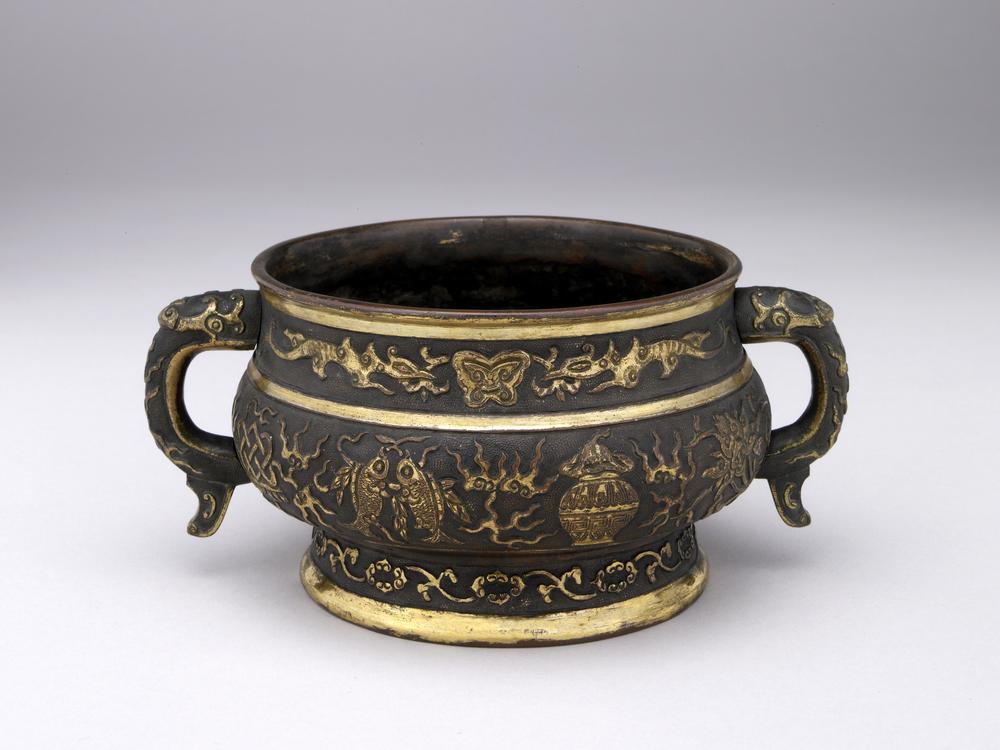Period:Five Dynasties and Ten Kingdoms Production date:10thC
Materials:silk, 絲綢 (Chinese),
Technique:painted
Subjects:bodhisattva hell mammal lotus monk/nun 菩薩 (Chinese) 地獄 (Chinese) 哺乳動物 (Chinese) 蓮花 (Chinese) 和尚/尼姑 (Chinese) 國王/王后 (Chinese) child
Dimensions:Height: 48.10 centimetres Width: 44.10 centimetres
Description:
Painting showing the hooded figure of Kṣitigarbha seated on a lotus with the Good and Bad Boys by his sides. The Six Ways of Life are represented by wavy lines emerging from the Bodhisattva’s nimbus. The monk Daoming, supposed author of the Sutra of the Ten Kings (Shiwang shengqi jing), is standing with his lion in front of him, and the Ten Kings of Hell kneel in two slanted lines. Of the ten, only Yama is distinguishable (by his mortarboard). Painted on a dark blue background, perhaps suggesting the netherworld, with gold leaf decoration. Ink and colour on silk.
IMG
![图片[1]-painting; 繪畫(Chinese) BM-1919-0101-0.9-China Archive](https://chinaarchive.net/Five Dynasties and Ten Kingdoms/Paintings/mid_00000237_001.jpg)
![图片[2]-painting; 繪畫(Chinese) BM-1919-0101-0.9-China Archive](https://chinaarchive.net/Five Dynasties and Ten Kingdoms/Paintings/mid_RFC609.jpg)
Comments:EnglishFrom Whitfield:In this painting on dark blue silk (Perhaps suggesting a setting in the nether regions of hell), Ksitigarbha’s countenance shines forth in gold, as do the diamond-shaped pieces of gold leaf on his robes and halo, and on the tips of the lotus petals of his throne (Pl. 23-2). Wavy lines standing for the Six Ways are seen on either side, but without the tiny figures seen in the previous plate. The Bodhisattva is accompanied by two figures in reverent attitudes who must be the Good (Fig. 29) and Bad (Fig. 30) Boys of the Sutra of the Ten Kings, who record good and evil respectively.The Ten Kings themselves are seen kneeling in two slanting rows to the left and right below the lotus throne (Figs. 31, 32), each holding a tablet. Among them only Yama, the fifth kings, can be identified by his mian 冕, or mortar-board, the nearest to Ksitigarbha on the right. Behind him stand two court officials, one holding a bulky roll of records. His counterpart on the opposite side pensively fingers the tip of a writing brush. In front, in the centre, there appears the priest Daoming道名,the supposed author of the Sutra of the Ten Kings, and his lion (Pl. 23-3), together with the figure of a man who may represent the soul asking for Ksitigarbha’s intercession.According to Waley, this depiction is a “condensed version” of the fuller representation of the Ten Kings that appears in the next plate, but if we follow Lothar Ledderose’s argument, this depiction of the Ten Kings together in two groups is an iconography that must precede the stage where each king has his own desk and courtroom attendants. A close parallel on paper is seen in Pl.62. ChineseFrom Whitfield 1983:此畫是繪在深藍色的絹底(大概是為象徵冥府設定的)上,地藏的臉部賦金彩,衣服和頭光、台座的蓮瓣上等都散嵌著菱形的碎箔(參照圖23-2)。地藏兩側騰起代表六道的波形線,但沒有插入如上圖的象徵性的小像。地藏兩側伴隨合掌的二童子,他們大概是《十王經》中記載的專司善和惡記錄的善童子(參照Fig.29)和惡童子(參照Fig.30)。十王各自執笏,在地藏蓮華座下方的左右斜著跪列(參照Fig.31、32)。其中,右列離地藏最近的王從其冕冠可以判斷他是第五王,即閻魔王。他背後站著兩個官人,其中一人懷裏抱著可能是記錄簿的大卷物。與此對應的畫面的左側位置上,站著一個沉思的手執筆的王。前景中央似乎是著錄《十王經》的僧道名、獅子(參照圖23-3),以及大概是請求地藏解救的亡靈的男人的身影。Waley認爲,比起下一圖所見的完整的十王,此幅是地獄十王的簡圖。有些被壓縮、變形。但是,據Lothar Ledderose教授的論點,如此分別在兩個組中的十王圖,是每個王前面有桌子、在隨行侍者的前身。圖62的《地藏十王圖》斷片中的表現相近的風格,那裏的十王在地藏兩旁,縱排各五身。
Materials:silk, 絲綢 (Chinese),
Technique:painted
Subjects:bodhisattva hell mammal lotus monk/nun 菩薩 (Chinese) 地獄 (Chinese) 哺乳動物 (Chinese) 蓮花 (Chinese) 和尚/尼姑 (Chinese) 國王/王后 (Chinese) child
Dimensions:Height: 48.10 centimetres Width: 44.10 centimetres
Description:
Painting showing the hooded figure of Kṣitigarbha seated on a lotus with the Good and Bad Boys by his sides. The Six Ways of Life are represented by wavy lines emerging from the Bodhisattva’s nimbus. The monk Daoming, supposed author of the Sutra of the Ten Kings (Shiwang shengqi jing), is standing with his lion in front of him, and the Ten Kings of Hell kneel in two slanted lines. Of the ten, only Yama is distinguishable (by his mortarboard). Painted on a dark blue background, perhaps suggesting the netherworld, with gold leaf decoration. Ink and colour on silk.
IMG
![图片[1]-painting; 繪畫(Chinese) BM-1919-0101-0.9-China Archive](https://chinaarchive.net/Five Dynasties and Ten Kingdoms/Paintings/mid_00000237_001.jpg)
![图片[2]-painting; 繪畫(Chinese) BM-1919-0101-0.9-China Archive](https://chinaarchive.net/Five Dynasties and Ten Kingdoms/Paintings/mid_RFC609.jpg)
Comments:EnglishFrom Whitfield:In this painting on dark blue silk (Perhaps suggesting a setting in the nether regions of hell), Ksitigarbha’s countenance shines forth in gold, as do the diamond-shaped pieces of gold leaf on his robes and halo, and on the tips of the lotus petals of his throne (Pl. 23-2). Wavy lines standing for the Six Ways are seen on either side, but without the tiny figures seen in the previous plate. The Bodhisattva is accompanied by two figures in reverent attitudes who must be the Good (Fig. 29) and Bad (Fig. 30) Boys of the Sutra of the Ten Kings, who record good and evil respectively.The Ten Kings themselves are seen kneeling in two slanting rows to the left and right below the lotus throne (Figs. 31, 32), each holding a tablet. Among them only Yama, the fifth kings, can be identified by his mian 冕, or mortar-board, the nearest to Ksitigarbha on the right. Behind him stand two court officials, one holding a bulky roll of records. His counterpart on the opposite side pensively fingers the tip of a writing brush. In front, in the centre, there appears the priest Daoming道名,the supposed author of the Sutra of the Ten Kings, and his lion (Pl. 23-3), together with the figure of a man who may represent the soul asking for Ksitigarbha’s intercession.According to Waley, this depiction is a “condensed version” of the fuller representation of the Ten Kings that appears in the next plate, but if we follow Lothar Ledderose’s argument, this depiction of the Ten Kings together in two groups is an iconography that must precede the stage where each king has his own desk and courtroom attendants. A close parallel on paper is seen in Pl.62. ChineseFrom Whitfield 1983:此畫是繪在深藍色的絹底(大概是為象徵冥府設定的)上,地藏的臉部賦金彩,衣服和頭光、台座的蓮瓣上等都散嵌著菱形的碎箔(參照圖23-2)。地藏兩側騰起代表六道的波形線,但沒有插入如上圖的象徵性的小像。地藏兩側伴隨合掌的二童子,他們大概是《十王經》中記載的專司善和惡記錄的善童子(參照Fig.29)和惡童子(參照Fig.30)。十王各自執笏,在地藏蓮華座下方的左右斜著跪列(參照Fig.31、32)。其中,右列離地藏最近的王從其冕冠可以判斷他是第五王,即閻魔王。他背後站著兩個官人,其中一人懷裏抱著可能是記錄簿的大卷物。與此對應的畫面的左側位置上,站著一個沉思的手執筆的王。前景中央似乎是著錄《十王經》的僧道名、獅子(參照圖23-3),以及大概是請求地藏解救的亡靈的男人的身影。Waley認爲,比起下一圖所見的完整的十王,此幅是地獄十王的簡圖。有些被壓縮、變形。但是,據Lothar Ledderose教授的論點,如此分別在兩個組中的十王圖,是每個王前面有桌子、在隨行侍者的前身。圖62的《地藏十王圖》斷片中的表現相近的風格,那裏的十王在地藏兩旁,縱排各五身。
© Copyright
The copyright of the article belongs to the author, please keep the original link for reprinting.
THE END
![[Qing Dynasty] British female painter—Elizabeth Keith, using woodblock prints to record China from the late Qing Dynasty to the early Republic of China—1915-China Archive](https://chinaarchive.net/wp-content/uploads/2022/11/image-191x300.png)




